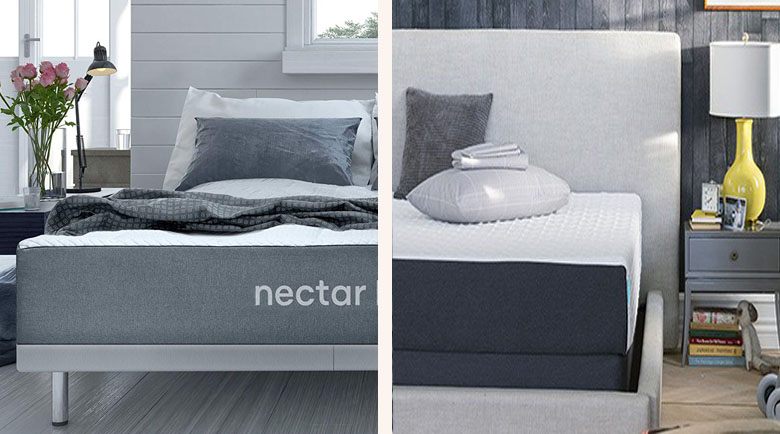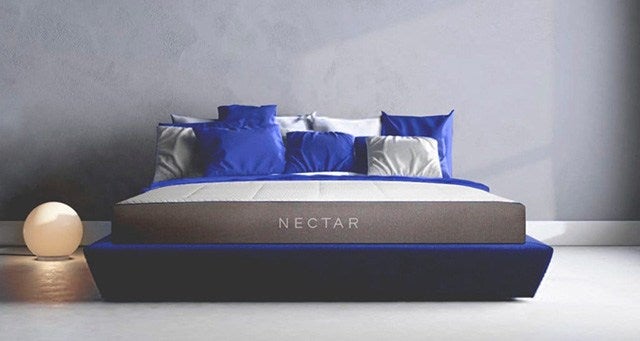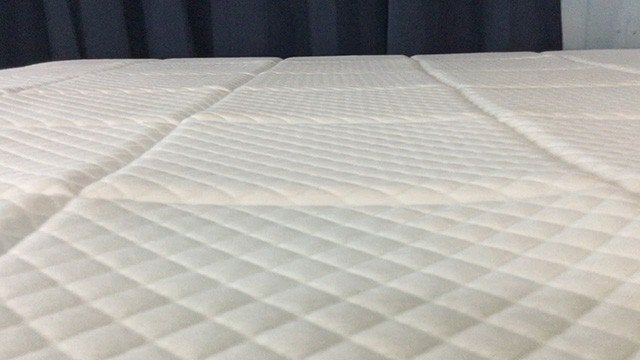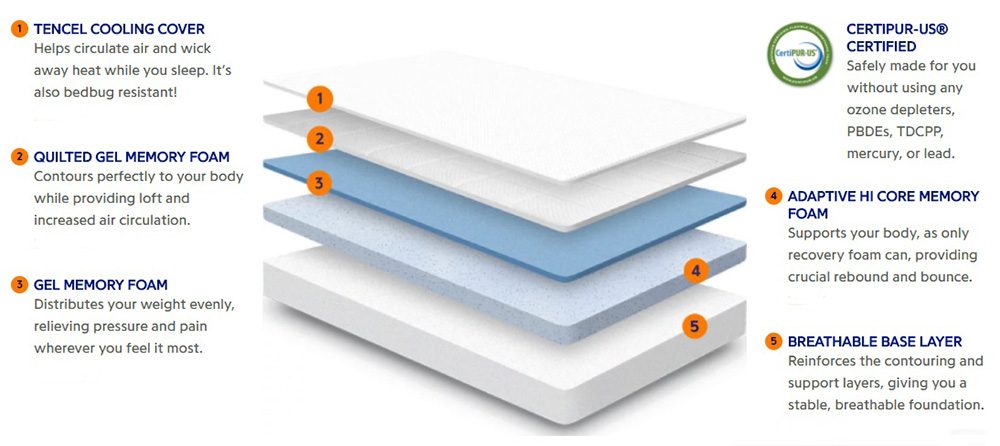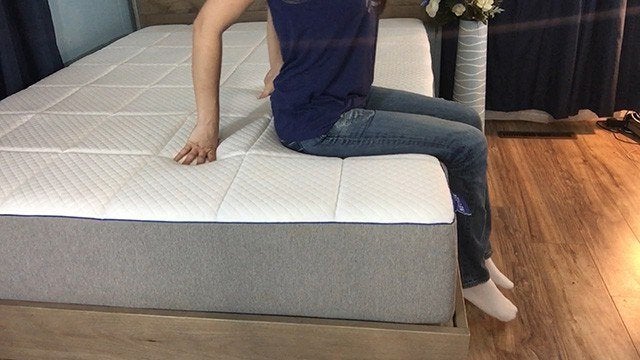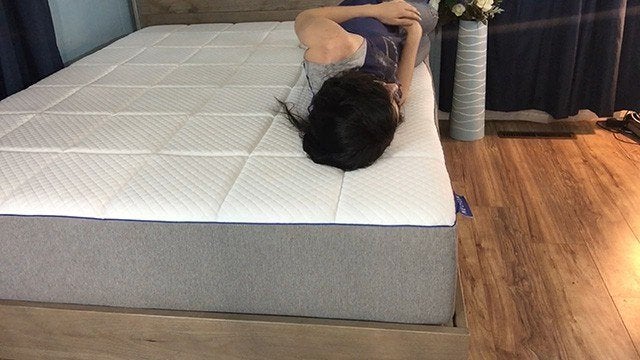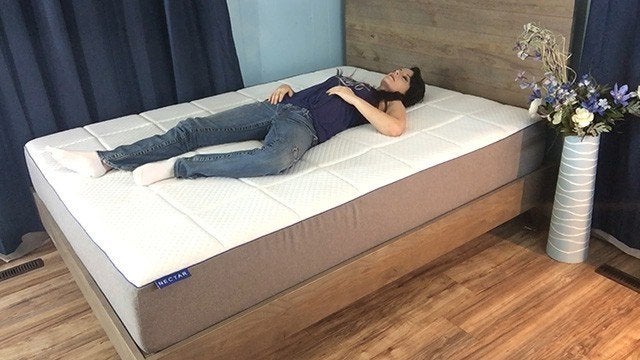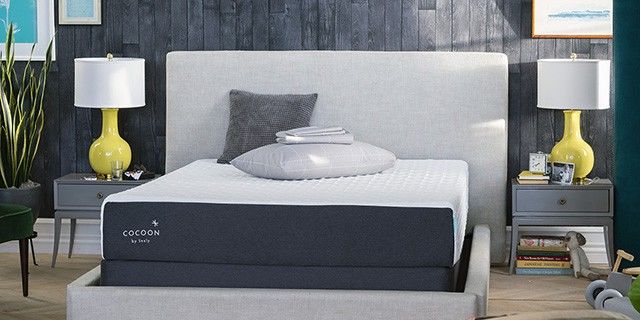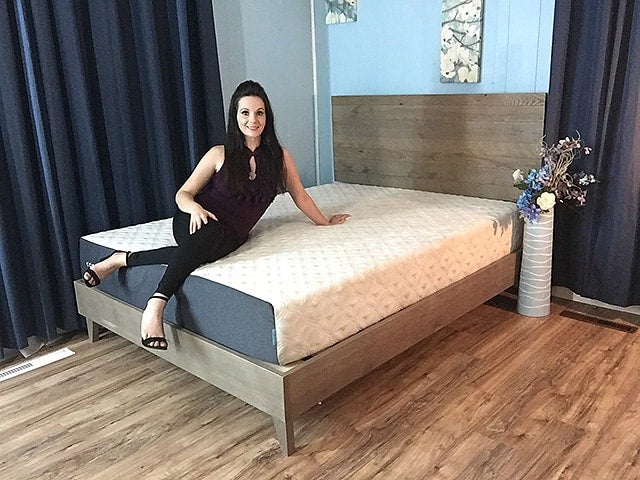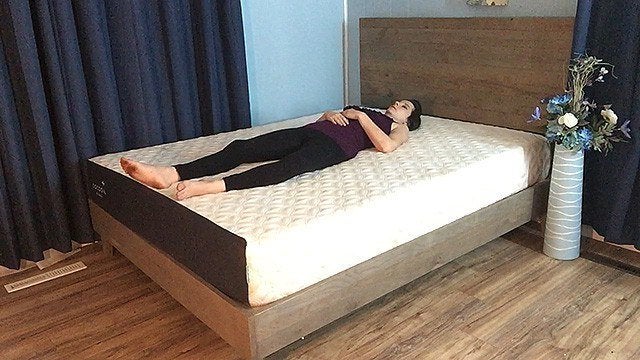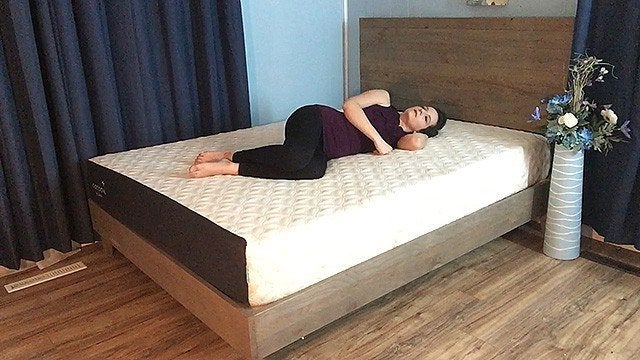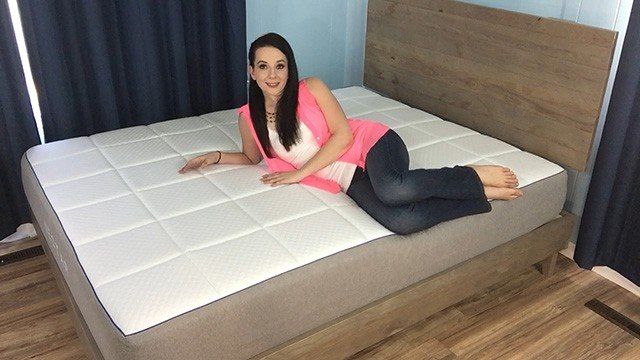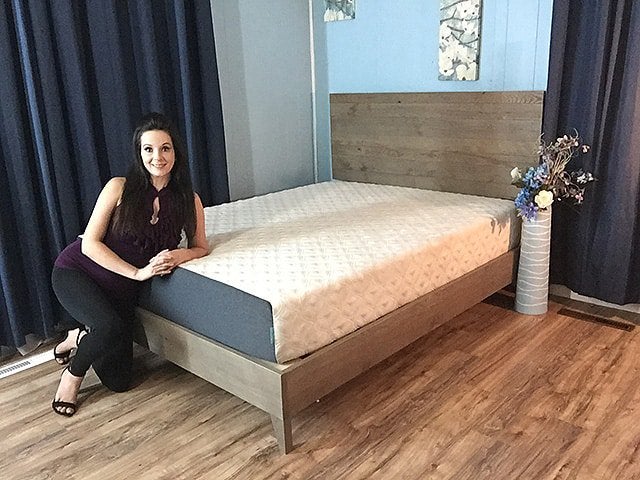Memory foam mattresses offer incomparable adaptability and contouring, which is why they are favored by a wide majority of sleepers looking for a customized, pressure relieving and cushioning sleep experience. However, the material suffers from a heat retention problem that runs as deep as its very molecular structure.
Over the years, different manufacturers have come up with different approaches to mitigate the heating problem, and today, I’ll be comparing two prominent viscoelastic mattresses that take unique approaches towards reducing the heat build-up – the Nectar mattress (a relative newcomer), and the Cocoon Chill mattress (made by Sealy, an industry veteran).
Continue reading this Nectar vs Cocoon comparison to see how these two viscoelastic products stack up.
Nectar Breakdown
The Nectar is a remarkably affordable memory foam mattress that incorporates liberal amounts of cooling gel-foam in its construction to handle the heating concerns of viscoelastic:
Construction
Cover
The Nectar’s cover is made from Tencel® fabric – a proprietary fiber derived from eucalyptus. The resulting cover is soft and cool, and even more breathable than cotton. Thanks to its superb moisture absorbency, it is also great at absorbing sweat, thereby preventing rashes and skin infections.
First Layer
This uppermost layer of the Nectar is made from 1” of quilted gel viscoelastic foam, at a plush ILD rating of 14. This makes it extremely soft and adaptive, which is precisely what is expected from a memory foam top layer. The layer provides initial contouring for your sleep posture and reduces the pressure of the impact that your body makes with the mattress.
The gel present inside the foam enables it to absorb heat inwards without letting you feel it on the surface.
Second Layer
The next layer is built out of slightly firmer 15 ILD gel viscoelastic foam, and is 3 inches deep. The added thickness and slight increase in firmness gives this layer more resistance to your weight, so that while it still contours to your body’s shape, it does so to a lesser degree, effectively slowing down the sinkage of your body into the mattress.
This layer also includes gel foam, and thus also contributes to the overall cooling of the mattress.
Third Layer
This is the transition layer of the mattress, responsible for bridging the gap between the soft upper layers and the stiff base that is to follow. While transition layers in other mattresses are generally an even mix of comfort and support, this one is a bit more abruptly firm at a relatively lofty 45 ILD rating. Nonetheless, it is still adaptive hi-core memory foam, which provides a resistive yet contouring response that is perfect for countering the pressure exerted by your body mass.
Fourth layer
5.5 inches of 2.2 lbs./cu.ft. 55 ILD polyurethane foam make up the base layer of the Nectar. The density and ILD rating both indicate that this layer is supposed to be long lasting and completely unyielding under pressure. This is necessary to prevent your body from sinking into an awkward angle while you sleep, which can lead to serious pain if not countered in a timely manner.
Firmness and Feel
The Nectar is available in a single medium-firm firmness level that is meant to be compatible with the sleep needs of the majority of sleepers.
Comfort and Support
The overall response of the Nectar is medium-firm (which is what they advertise). The mattress yields a combination of conforming pressure relief and stiff support, which may be slightly tipped towards the firm side because of how the lower two layers become so abruptly hard. However, this isn’t unpleasant – what it means is that your body won’t sink right through the mattress (something that bulkier individuals are acutely familiar with).
Compared to the Cocoon though, the Nectar is still closer in its response to a true memory foam mattress, since the latter incorporates a proprietary viscoelastic foam that is response in addition to being contouring.
Edge Support
Thanks to the unusually firm base and intermediate layers of the Nectar, it yields a more supportive sitting surface than most other memory foam mattresses. This improvement is noticeable at the sides of the bed as well – there is much less sinking, so you can sit there for extended periods of time without slipping or feeling uncomfortable.
Cooling
The upper two layers, despite being made from memory foam, are able to contain a significant amount of heat inside them before you start feeling hot on the surface – this is a result of the gel crystals that are present in their foam structure. Unless the weather is extremely hot, the breathable base is able to ventilate this accumulated heat in a timely manner and of course, the extra-breathable Tencel® cover helps as well.
That being said, the Nectar’s passive cooling mechanisms are not as effective as the Cocoon’s active PCM technology.
Motion Transfer
Thanks to the viscoelastic response of the two upper layers, the Nectar absorbs practically all impacts immediately, preventing them from creating disturbing ripples across the bed that could potentially disturb the sleeper(s).
Unique Features
Affordable pricing
Surprising for the number of features it contains and the quality it embodies, the Nectar costs just $799 for the Queen size. In fact, cooling aside, it outmatches the Cocoon objectively in all other regards: organic cover – check, durable foam layers – check, longer trial period – check, lifetime warranty – check. Thus, if you’re willing to put up with a potentially warmer bed and some typically slow responding memory foam, the Nectar objectively offers more value for the money!
Organic based cover
The cover of the Nectar is derived from an organic material, which makes it more skin-friendly and safe. This isn’t to say that the stretch-knit PCM cover of the Cocoon is harmful – both mattresses are CertiPUR-US certified after all, it’s just that the Tencel is better at absorbing moisture that can lead to skin irritation, and it doesn’t carry the (arguably slight) risk of a plastic allergy.
Typical memory foam feel with reduced sinkage
Thanks to the combination of highly contouring upper layers and rapidly stiffening lower layers, the Nectar is able to create a feel that is adaptive like memory foam but with reduced sinkage. Despite this, I should clarify here that the Nectar’s response is still slowly enveloping, whereas the Cocoon’s response combines viscoelastic contouring with a healthy amount of bounce-back.
Longer trial period
The Nectar comes with a 365-day trial policy compared to the 100-nights trial offered by the Sealy Cocoon. This is especially impressive when considered in conjunction with the fact that the Nectar is also considerably cheaper than the Sealy!
Longer warranty
Again, the Nectar punches well above its weight with a lifetime warranty that is far beyond what the industry normally offers 10 years (this is, incidentally, also what the Cocoon comes with). While normally I don’t go for the notion that a longer warranty means better durability, in this case, considering the durability of the foam and the fact that the manufacturer commits to their product for life, I would have to say the Nectar seems to be one of the rare examples where I would advocate the contrary.
Cocoon Breakdown
The Cocoon is a budget friendly memory foam mattress developed by seasoned mattress maker Sealy, in an attempt to yield a cool and comfortable viscoelastic solution for the mainstream consumer:
Construction
Cover
The Cocoon chill has a high-quality stretch-knit cover enveloping its underlying layers, giving it a clean, streamlined aesthetic. But this cover isn’t just there to provide you with a nice looking, soft sleeping surface – it is in fact the heart of the Cocoon’s ‘cool-to-the-touch’ design philosophy thanks to its incorporation of phase change materials.
The cover incorporates special phase change material that can absorb considerable amounts of heat (that would otherwise cause a rise in the temperature of the mattress), so that you don’t have to deal with the temperature rise that is normally associated with memory foam products. Even better, if you start feeling too cold, the PCM material will release heat back into the surroundings to warm you up.
In a nutshell, the PCM mechanism ensures that you get an optimum temperature for sleep – something that most memory foam mattresses cannot achieve.
First Layer
The uppermost proper layer of the mattress is made out of special ‘Perfect Fit’ memory foam that offers an adaptive and comfortable response that is exactly in line with most viscoelastic mattresses. However, it does differ in one aspect: it won’t envelope you excessively like you would expect from a viscoelastic product – indeed, it facilitates in entering and exiting the bed, and changing positions during sleep.
The density of this layer is 3 lbs./cu.ft. and the depth is 2 inches. In all fairness, the density is a bit stingy in terms of durability (you would ideally want something between 4-5 lbs. for reliable long term results).
Second Layer
The next layer is comprises of 2 inches of 1.8 lbs./cu.ft. polyurethane foam. At the time of purchase, you can personalize this layer with either a ‘soft’ version or a ‘firm’ version, so it can be interpreted that this layer is responsible for the overall feel of the mattress, and for generating intermediate support that stoppers your weight from sinking in deeper.
Third Layer
The final layer is 6 inches of polyurethane foam, also at a density of 1.8 lbs./cu.ft. This layer yields the deep support which your body needs to stay in correct alignment – it stops your body from going any further (if the intermediate layer hasn’t already done this). In line with its supportive role, this layer is designed to be resilient and long lasting.
Note that both the second and third layers’ densities meet the threshold for durability, in contrast with the uppermost layer.
Firmness and Feel
The Cocoon Chill is available in two firmness levels – which the manufacturer designates simply as soft and firm, but from personal experience, I can elaborate as medium-firm and firm.
Comfort and Support
Soft (Medium-Firm)
This variant provides you with the signature memory foam experience – plush, contouring and pressure relieving. It achieves this by using the ‘soft’ second layer, as described above. The general idea of the manufacturer with this variant is to yield a response that makes you feel like you’re sleeping ‘in the bed’.
While an explicit ILD rating has not been disclosed by the manufacturer, they do indicate its firmness on a relative scale from 1 to 10. According to this scale, this variant works for people who have a preference for a feel between 2 and 7. This in itself is something of a vague statement, but judging from the fact that this is the vastly more popular variant of the two, I would say it does cater to the needs of the mainstream.
Firm
This variant is more resistive, intended to yield a feel that focuses less on viscoelastic contouring and more on resilient support. The feel is achieved through the incorporation of a ‘firm’ second layer, which is meant to create a sensation of sleeping ‘on the bed’.
Again, no ILD rating is mentioned, but on the aforementioned scale, the manufacturer designates a 7 to 10 rating for this mattress. In comparison to the ‘Soft’ variant, this one is more in line with the needs of a small consumer segment that wants less-than-normal contouring from their memory foam mattress.
Regardless of the option you go for, it is worth mentioning once again that the uppermost Perfect fit layer (which is the only viscoelastic layer of the mattress), is less ‘sinking’ than is the norm for such products – in fact it is unusually swift in regain its original shape once pressure is removed.
Edge Support
Surprising for a memory foam that shows resilience in its behavior, the Cocoon suffers from a slightly unsatisfactory edge support response – don’t expect significant support when you’re sitting on the side of your bed. However, this isn’t a major drawback, considering that most memory foam products suffer from this problem as well (the Nectar does fare somewhat better in this department though).
Cooling
This is where the Cocoon Chill really shines – thanks to the Phase Change Material described above, the mattress is able to actively maintain a comfortable sleeping temperature overnight, and in fact, is significantly faster at cooling down compared to other viscoelastic foam products. The Nectar, with its Tencel cover and gel foam infusion, is still not able to keep up with the Cocoon in this regard.
Motion Transfer
As is customary for viscoelastic mattresses, the Cocoon is quite effective at blocking out sudden impacts on its surface, preventing them from transmitting into the neighboring regions. That said, thanks to the added resilience of the Perfect Fit layer, there is a slight degree of bounciness in the mattress. However, this is insignificant, and should not disturb all but the most sensitive of sleep partners.
Unique Features
Contouring yet responsive behavior
The Perfect Fit memory foam layer that sits on top of the Cocoon’s composition is responsible for generating the conforming, cradling sensation that you want from a viscoelastic mattress. Depending on the firmness level you opt for, it produces this to a greater or lesser degree. However, what is decidedly absent is the sluggish behavior of ordinary memory foam, where it takes a while to adapt to changes in your posture.
In this regard, the Cocoon distinguishes itself from the competition (including the Nectar) – it is a viscoelastic mattress that doesn’t make you feel like you’re sleeping in a crater!
Multiple firmness options
The Cocoon comes in two distinct firmness levels, compared to the solitary Medium-Firm level offered by the Nectar. This enables it to target both regular memory foam fans and those who want some more support than ordinary viscoelastic mattresses produce.
Impressive temperature regulation
The cocoon lacks an impressive array of cooling features like other brands advertise: breathable air channels, gel foam, organic cover, convoluted construction. It simply uses one cooling mechanism so powerful and effective that it gets far ahead of the competition just by that: phase change materials – hi-tech stuff that can actively work towards maintaining a comfortable temperature for your body.
The best part is that it works both ways – it’ll absorb heat when it gets hot and emit heat when it gets cold, so you can enjoy a restful sleep throughout the night, impervious to temperature changes in the environment.
Check out our unboxing article here
Which One To Get?
Nectar
Here are some reasons to choose the Nectar over the Cocoon:
- You want a conventional memory foam response: While the Adaptive Hi-Core foam layer present between the base and the upper viscoelastic layers does create some resistivity, the overall response is predominantly the same sluggish, adaptive behavior that characterizes memory foam.
- If you enjoy sleeping on a bed that cradles around your sleep posture, then the Nectar is the better option since the Cocoon has a more reactive response.
- You’re on a budget: The Nectar is priced $100 less than the Cocoon, and offers remarkable value despite this cost reduction – more durable foam layers, a longer trial period and warranty, an organic cover. For this reason, if you’re restricted by a tight budget, you won’t be compromising a great deal if you go for the Nectar instead of the Cocoon (except perhaps in terms of heat dissipation).
- You’d prefer an organic cover: The Cocoon’s PCM infused cover may have remarkable cooling benefits, but if you’re averse to being in contact with synthetic materials, then nothing but an organic cover will make you happy. The Nectar’s Tencel® based cover fulfils this requirement, and is cool, soft and highly breathable in its own right.
- On a related note, if you tend to sweat a lot due to a medical condition (and not high temperature), the Tencel® cover’s breathability makes the Nectar a more suitable option in this case too.
- Edge support is a priority: The superior edge support of the Nectar makes it a better choice for individuals who want an all-foam mattress that can hold up their weight when they’re sitting on the side of the bed for long periods of time – exact situations could be looking after a sick family member or reading to a child before bed.
- Durability is required: The greater durability of the Nectar makes it a viable option for people who want a mattress that will provide superb pressure relief and support year after year. If you’re willing to put up with some sinkage, this also makes it a better choice if you’re a bulky individual, since your weight is likely to produce a greater wearing effect on the foam.
- You want more time to make up your mind: Thanks to the extremely generous yearlong trial period of the Nectar, you’ve got plenty of time to decide if a memory foam mattress is the perfect solution for your sleep requirements. The Cocoon also comes with a 100-day trial, but it is disappointing considering that it priced higher. Moreover, a yearlong trial gives you the opportunity to test the suitability of the mattress in every season.
- A longer warranty matters to you: If you consider that a longer warranty of a mattress is indicative of greater durability, then the Nectar’s lifetime warranty (compared to the Sealy’s 10-year warranty) makes it the unquestionably superior option in this comparison.
- You have to know the specs of your purchase: The Nectar clearly states the ILD values of each constituent layer of the mattress, which makes it easy (for sleep geeks) to figure out the kind of firmness level they are going to get out of it – this can be an important deciding factor considering that these mattresses are sold online.
Cocoon
Alternatively, you may want to choose the Cocoon over the Nectar if:
- You want a memory foam response with some responsiveness: The Perfect Fit memory foam that I’ve described in detail above yields both conformity and responsiveness – which isn’t a common combination in memory foam mattresses. Nonetheless, the Cocoon achieves this admirably, so if you’ve ever hesitated from getting a viscoelastic mattress because it couldn’t keep up with your changing sleep positions, it may be worth a look.
- Similarly, if you’ve had trouble getting in and out of bed because of a non-reactive mattress, again, the Cocoon is a better choice than the Nectar.
- You are sensitive to temperature changes in bed: The PCM mechanism built into the cover of the Cocoon Chill lends the mattress the ability to dynamically adapt to changes in temperature – in other words, you’ll get a perfectly balanced temperature for sleep regardless of the ambient temperature conditions in your room.
- You want a firmer than usual viscoelastic bed: If you’re a bulky individual, or simply dislike the extreme cushioning that is prevalent in memory foam mattresses, the Firm variant of the Cocoon may provide you with a solution that is more palatable – it focuses somewhat more on resistive support, without completely losing the essence of a viscoelastic bed.
- Thus, you will experience less sinkage while still enjoy a healthy amount of pressure relief.
- Bragging rights matter for you: Sealy is one of the pioneering names in the mattress industry, so if you want to advertise your mattress purchase (perhaps you’re getting it for a commercial establishment, or you’re just looking to wow your guests), then the Sealy Cocoon will definitely be more recognizable than the Nectar.
I hope this comparison of two mainstream memory foam mattresses was useful for you – in particular, you should have learned something about how the industry is going about dealing with the heating issues of memory foam. You can address any further questions or feedback in the comments section below, and do remember to share this post with others who may be interested in purchasing a viscoelastic mattress.
Nectar vs Cocoon Comparison
| Nectar | Cocoon | |
|---|---|---|
| Layers Used |
|
|
| Height | 11 inches | 10 inches |
| Firmness | Medium-Firm | Medium-Firm, Firm |
| Motion Transfer | Minimal | Minimal |
| Breathability | Slightly below average | Above average |
| Trial Period | 365-day | 100-nights |
| Warranty | Lifetime | 10-years |
| Pricing (Queen) | $799 | $949 |
| Shipping | Free | Free |
